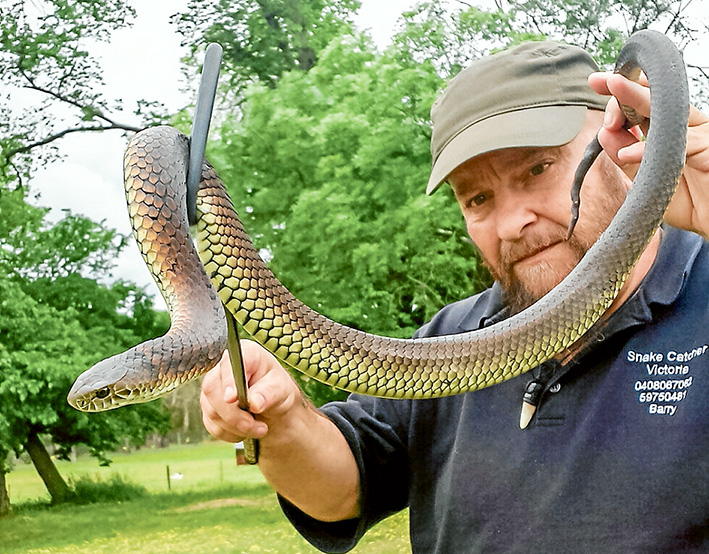
FORGET the Chinese Year of the Sheep or Goat, in terms of snakes in the Mornington Peninsula, Frankston and southeast region, it’s the year of the copperhead snake.
Peninsula licensed wildlife controller Barry Goldsmith says the copperhead is the dominant type of snake appearing as the weather warms, displacing last year’s “year of the tiger snake”. “I’ve been removing on average two a day since the warm weather kicked in,” he said.
Mr Goldsmith scotched the myth that there are more snakes around this year as animal hospitals and vets report a sharp increase in pets being bitten by snakes compared with this time last year.
“It’s very simple – as we reduce snake habitat by development, humans and their pets are more likely to come into contact with snakes even though we have fewer snakes than, say, 20 years ago,” he said.
Building of homes, shops, roads and other infrastructure in the region is also reducing the number of places where snake-catchers can release their captures.
He cited development in Mornington, Somerville and Rosebud in recent times for creating greater chances of humans (and their pets) encountering snakes.
“What is now the Peninsula Sands estate in Rosebud South was a place where snake-catchers released relocated snakes for 100 years,” he said.
Mr Goldsmith is a champion of snakes, regularly warning that it is illegal to kill snakes, and could attract a fine of more than $6000.
“It’s not only illegal but also dangerous as people could be exposing themselves to potential injury or death,” he said.
“The head of a decapitated snake can live for 15 minutes or more and still bite. There was a case in NSW where a man cut a black snake in half and returned to dispose of it 24 hours later. He grabbed the front half and it bit him.
“People need to be aware snakes are moving around looking for food and water; if you see a snake in your garden, leave it alone and you won’t have a problem.”
Killing a snake on your property would just leave a vacuum that would be filled by another snake, he said.
The three most common snakes in the region are copperheads, tiger snakes and red-bellied black snakes.
“Having a copperhead or red-bellied black snake on your property is a good thing as they eat tiger snakes, which are more likely to bite humans and pets,” he said.
“Tigers seek prey such as mice and rats, which live in sheds and houses, as well as birds and small mammals.
“Copperheads mainly seek frogs, lizards – and other snakes.”
Mr Goldsmith also warned about pets and snakes. “Snakes don’t attack dogs; dogs attack snakes,” he said.
Veterinarians say dogs should be kept on a leash in dunes, long grass, bushland and beside creeks.
Snake bites are difficult to detect on dogs and cats. First reactions can include trembling, rapid breathing, vomiting, defecation and collapse. After some of these signs, eye pupils may dilate (get bigger) and the animal’s gait will become clumsy as the legs become progressively weaker.
If the dose of venom is large enough, complete paralysis will occur, followed by death if untreated with anti-venom.
If treated immediately, pets have a good chance of survival and recovery. The best course of action is to keep your pet as calm and still as possible and get them to a vet.
Information: snakecatchervictoria.com.au